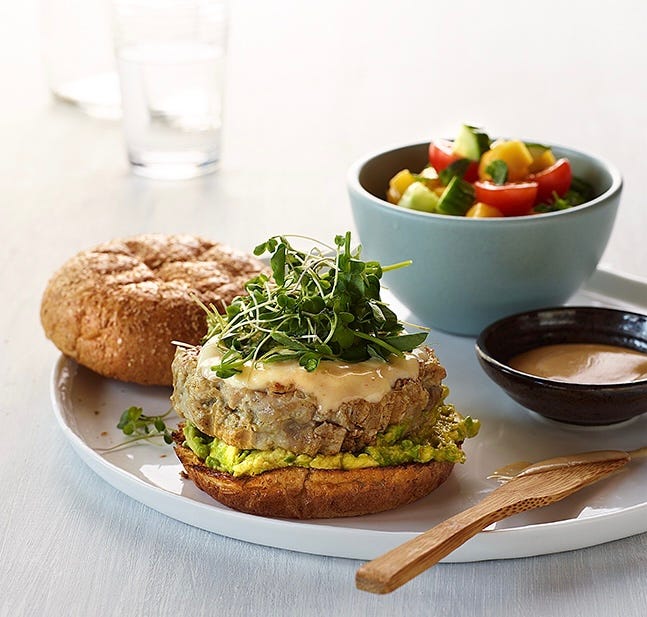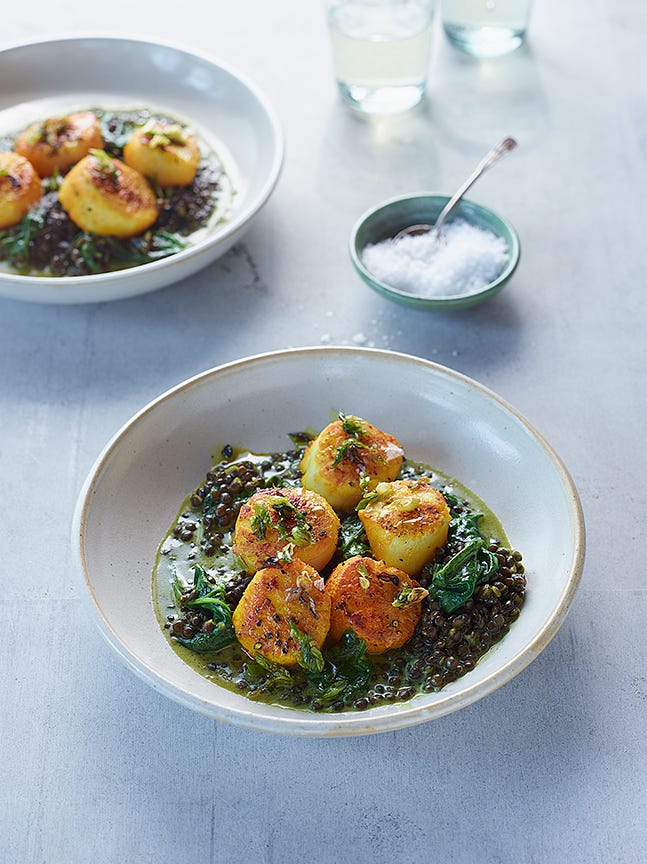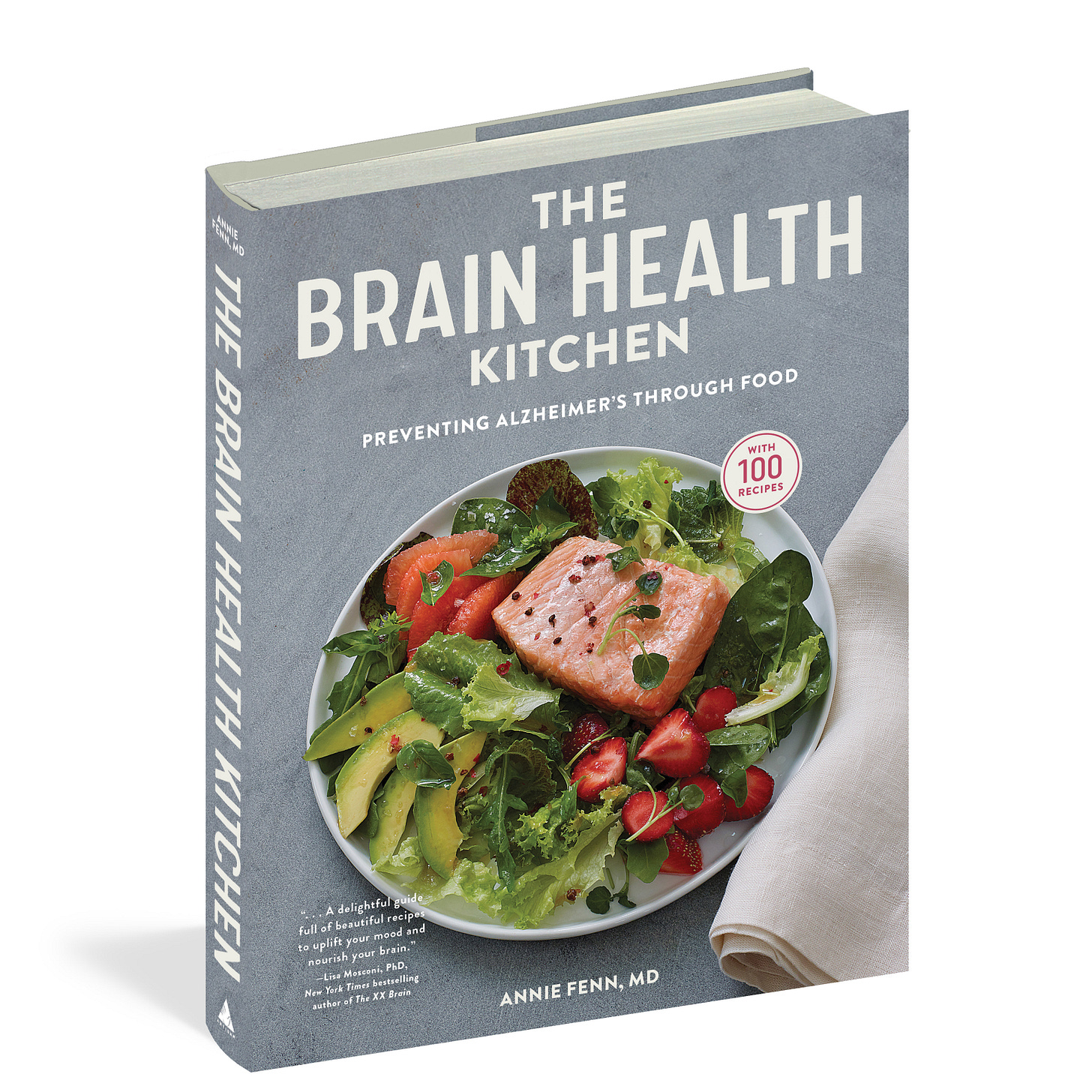How To Get Enough Protein In A Brain-Healthy Diet
Myths vs. facts, plus my top 10 protein-packed picks

Hello, everyone. I’m writing from the deck off my kitchen, where my herb garden is bursting to life with sage, mint, thyme, lavender, chives, and basil. As I dive into today’s topic, I have a tiny patient next to me in a shoe box. I’ve been feeding this fallen hummingbird sugar water from a dropper since I found it in distress three days ago. I’ll share some cool facts I’ve learned about these luminous creatures at the end of this newsletter.
Over the past months, I’ve been soliciting ideas for what readers’ want to know about. Many have asked about getting enough dietary protein in a brain-healthy diet. Because it’s such a popular question, I am including it in today’s newsletter, the first of the month, which goes out to all subscribers (both free and paying) so feel free to share.
If you’ve already shifted your eating habits to follow one of the proven brain-protective dietary patterns (the Mediterranean or MIND diets, outlined in the BHK Food Guidelines in my book), you may be able to slash the risk of getting Alzheimer’s in half. Bravo! But you may also be wondering if you are getting enough protein. This is a valid concern. After all, these guidelines call for cutting back on many of the foods that are staple protein sources in the American diet, like red meat and dairy products. I cannot overstate how important it is to consume enough protein in order to age well. And I assure you it’s possible while following brain-protective dietary guidelines. Read on to learn why, and for my 10 favorite protein-packed brain foods.
Protein 101
First, some basics. Protein is a macronutrient, just like fats and carbohydrates. Soon after eating a protein-rich food, your body breaks it down into its components, called amino acids. There are 20 different amino acids that make up the protein in food. Of these, 9 are essential—meaning your body cannot synthesize them—so you must get them from food. (More on this later.) Amino acids serve as building blocks for muscle, hormones, neurotransmitters, and molecules needed for a healthy immune system.
How Much Protein Do You Need? Simple Question, Complicated Answer

According to the U.S. government, the recommended dietary allowance (RDA) for protein intake is 0.8 grams of protein for each kilogram of body weight, or 0.36 grams per pound of body weight. For a 140 pound woman, for example, this translates to 50 grams of protein or the amount in a 6-ounce portion of chicken breast.
Sounds low, doesn’t it? That’s because the RDA is based on how much protein it takes to maintain nitrogen balance in a 25-year old male. It doesn’t take into account whether you are male or female, your stage of life, or how physically active you are. Basically, it’s the rock bottom low needed to avoid deficiency states.
Most experts agree that the RDA’s protein recommendation is woefully inadequate. You may read it’s better to consume twice or even three times the RDA in protein. It gets confusing because there’s a camp of longevity researchers who advocate for a low-protein diet at mid-life. And, if you mention to your physician that you are on a high protein diet, he or she may warn you it could have a negative impact on kidney function. High, low, or in line with the RDA—what level is best for brain health? First, let’s look at the most compelling data—that which pertains to older adults.
Older Adults Age Better with More Protein
Getting enough protein is emerging as a key factor in successful aging. According to recent studies, adults over age 65 age with healthier brains if protein intake is at least double the RDA, or 1.6 grams per kilogram of body weight, or 0.72 grams per pound. Yes, if you are doing the math, that is a lot of protein.
The Cache County Dementia Progression Study showed a strong association between low protein intake and dementia. In fact, the lower the intake, the more severe the dementia.
In this study of adults over 65, higher protein intake was positively associated with memory function. Those adults with the highest protein intake also had the lowest incidence of mild cognitive impairment.
In this study published in the Journal of Alzheimer’s Disease, healthy older adults with a high protein intake had less amyloid-β accumulation in the brain, when compared to those with medium to low intake. In fact, those in the lowest tier of protein intake were 12 times more likely to have a high burden of amyloid protein visualized on brain imaging studies.
It’s not clear yet if protein helps the aging brain through a direct mechanism, such as providing certain amino acids needed to boost neurotransmitters. Or, if protein intake helps the brain indirectly by preventing muscle loss and frailty, which can lead to a less active and engaged brain-healthy lifestyle. Whatever the reason, adults who maintain muscle mass as they age also tend to have healthier brains.
Is It Harmful to Eat Too Much Protein?
It’s a myth that consuming too much protein will give you kidney problems, or any other health problems. People with certain types of kidney disease, however, should discuss optimal protein intake with their physicians. Protein that doesn’t go to build muscles or other bodily tasks will just get efficiently excreted via the kidneys as urea.
The Bottom Line: It’s better to err on the side of getting more protein than you need than not getting enough. Optimal protein intake is crucial for your body and your brain as you age.
Here are my top brain-healthy foods that also provide substantial doses of protein.
My top 10 Protein-Rich Brain Foods (7 Are Plant Based)

Almonds: With the most protein per ounce of all the tree nuts (about 7 grams per ¼ cup), almonds also give you brain-friendly monounsaturated fats and vitamin E. The MIND diet guidelines recommend eating ¼ cup nuts (or 2 tablespoons of nut butter) 4 times each week.
Black beluga lentils: Not only does this variety of lentils pack in the most fiber, it gives you 25 grams of protein per cup (cooked).
Green peas: A cup provides 8 grams of protein, making these vegetable-like legumes an easy way to add protein to meals. Keep a bag of frozen peas in the freezer and add liberally to salads, soups, and stews.
Edamame: These snackable pods served in Japanese restaurants give you 16 grams of protein per cup. You can enjoy them at home, too, by keeping a bag of frozen edamame (in the pod or not) on hand to add to meals (like the Cauliflower Kimchi Fried Rice on page 133 of my book) or puree into a bright green dip.
Lean poultry: While eggs have a reputation for being high in protein (6 grams per egg), a 3-ounce portion of boneless, skinless chicken breast gives you about 25 grams. Poultry is included as one of the MIND diet’s 10 brain-healthy food groups as an important source of niacin, choline, and lutein.
Fish: The brain-healthiest fish are rich in DHA and EPA— the type of omega-3 fats the brain needs to thrive. Bonus: these fish are also high in protein with about 25 grams per 3-ounce portion: yellowtail, light canned tuna, anchovies, sardines, coho salmon, tilapia, trout, and snapper.
Greek yogurt: This thick and creamy style is very high in protein—you’ll get 15 to 18 grams per cup compared to just 10 grams for regular yogurt. Choose plain, unsweetened Greek yogurt to get all the protein without added sugar or artificial ingredients. Plus, it counts as a serving of fermented food in the Brain Health Kitchen Food Guidelines. My top picks are Fage Total and dairy-free Kite Hill Plant-Based made with almond and soy milk.
Quinoa: This seed-like grain is one of the few plant foods that provides all 9 essential amino acids. Plus, you get 10 grams of protein, with each cup (cooked), and a whole roster of brain health nutrients. (Have you tried my Fudgy Quinoa Brownies yet?) And don’t forget the other seeds—hemp, sesame, chia, pumpkin, and sunflower seeds pack in between 8 and 10 grams of protein per quarter cup. I gave you some ideas for eating more seeds here.
Spinach and collard greens: A brain-healthy diet includes 1 to 2 cups of leafy greens each day. Make it one of the dark varieties, and you’ll get a protein boost, too. One-cup (cooked) serving gives you 5 grams of protein, along with essential brain health nutrients shown to slow down the aging of the brain.
Tofu: With about 10 grams for each half-cup serving, tofu is an excellent plant-based protein source. Other whole soy foods give you even more (about 20 grams in tempeh and seitan), but I love tofu for its versatility and mild flavor. It’s also a complete protein, see below.
Getting Enough Protein in a Plant-Based Diet
If your diet excludes animal products, which are rich in the essential amino acids and considered “complete proteins,” you can still get what you need by eating a variety of plant foods. Three plant proteins stand out as complete proteins: soy foods, peas, and quinoa. Variety is key for plant-based eaters because many protein sources, like beans, grains, nuts, and seeds, provide some but not all of the essential amino acids. Following a restrictive diet, such as one that eliminates grains or beans, can make it challenging for a plant-based eater to get those 9 essentials needed for healthy aging.
What About Branched Chain Amino Acids?
Some essential amino acids may be more important than others. The branched chain amino acids(BCAA)—leucine, isoleucine, and valine—are especially key for building muscle. Leucine, for example, stimulates the rate at which the body transforms dietary protein into muscle and improves strength. Salmon, chicken, ground beef, turkey, yogurt, canned tuna and eggs are rich in BCAAs, especially leucine. Vegans and vegetarians can get it from soy whole foods, brown rice, beans (especially chickpeas), and pea protein powder.
Controversies Around Protein Intake Abound
Double the RDA may not be enough protein if you are very physically active. If you are following exercise guidelines for reducing Alzheimer’s risk, you may need up to triple the RDA. And, you need to be strategic about when and how you dose your protein intake. What is the best time of day to consume a protein-rich meal? What is the impact of intermittent fasting? Should you rely on protein powders to get to your optimal intake? If so, what kind? Plus, what does a day of protein-rich eating look like in a brain-healthy diet? I’ll go into this and more in next week’s newsletter.
Now I have a few questions for you:
What is your biggest challenge when trying to get enough protein? What is your go-to protein-rich snack?
Win a Book in Honor of the Brain Health Kitchen Book’s 6-Month Birthday
It’s hard to believe The Brain Health Kitchen: Preventing Alzheimer’s Through Food is already 6 months old. To celebrate, I am giving away one copy of my book to a new paying BHK newsletter subscriber this month. Here’s how to win: 1) Purchase an annual or Founding Member subscription between now and July 10, 2023 at 11 pm MST. 2) Check your email next week. That’s it! A winner will be chosen by random number generator and notified by email. You must live in the U.S. to enter. As our community here grows, so does the knowledge of how to protect your brain for life. I am grateful to each and every one of you out there helping me spread the word.
If you are already enjoying the book, it would mean the world to me if you’d leave a review on Amazon or Goodreads.
What I Learned While Taking Care of a Hummingbird for 3 Days
Finally, I’ll leave with you my bittersweet experience of getting to nurse a fallen hummingbird. Sprite, as she became known at our house, was a tiny but fierce hummer with chest feathers that changed moment by moment from red to orange to gold. Just as the busyness of summer was ramping up, Sprite taught me to slow down and take notice of her many small beautiful things.
Hummingbirds have the largest heart of any animal for its size. And they have the fastest heart rate, beating at 1200 beats per minute.
Of all the wild birds, hummingbirds have the biggest brains, accounting for 4.2% of its body weight.
When cold, a hummingbird will puff out its feathers like it’s looking for a mate.
A hummingbird’s beak opens like chopsticks to reveal a needle-like tongue, perfectly grooved for lapping up nectar and capturing bugs.
Hummingbirds have amazing memories! They remember every flower and feeder they’ve visited, as well as how long it takes for a certain flower to refill with nectar. And, they visit about 1,000 flowers each day.
While hummingbirds are attracted to feeders filled with sugar water, they actually prefer whole food sources of sugar from flowers.
Latin American mystics believe that when you spot a hummingbird, it signifies the soul of a loved one stopping by to say hello.
People are sweet. Really sweet. Ok, I already knew this but I was astounded by the thousands of people following little Sprite’s plight in my Instagram stories. I received hundreds of messages each day; every single one was supportive, helpful, and caring.
As always, thank you for reading, sharing, and taking the best care of your brains. I’ll be back this weekend with 5 Brain-Healthy Things I’m Into This Summer. Take care, friends.
Love,
Annie
.






Hi Michele! I’m glad this is helpful. Will be addressing calcium intake in an upcoming
newsletter.
Hi Annie,
Thank you for this information about protein intake and brain health. I have read so much about the need to increase protein in your diet post-menopause to maintain/support muscle mass (and therefore maintain a healthy weight), but I didn’t realize the correlation to brain health. Very helpful! My grandmother grew up very poor - she told me how she was always hungry as a child and rarely ate any protein - it was a luxury. She was diagnosed with Alzheimers in her early 60s…
My favorite snack is high-protein, firm tofu from Trader Joe’s - I cut it into cubes, spray a tray with avocado oil & toast it in the toaster oven for 30 min. I eat a serving as a snack in the afternoon & it’s very satisfying. Looking forward to reading your next newsletter about protein powders & hearing other high-protein snack suggestions. Thank you so much for the important work you are doing. It is incredibly educational and valuable. So grateful I met you at Rancho La Puerta in early 2020.